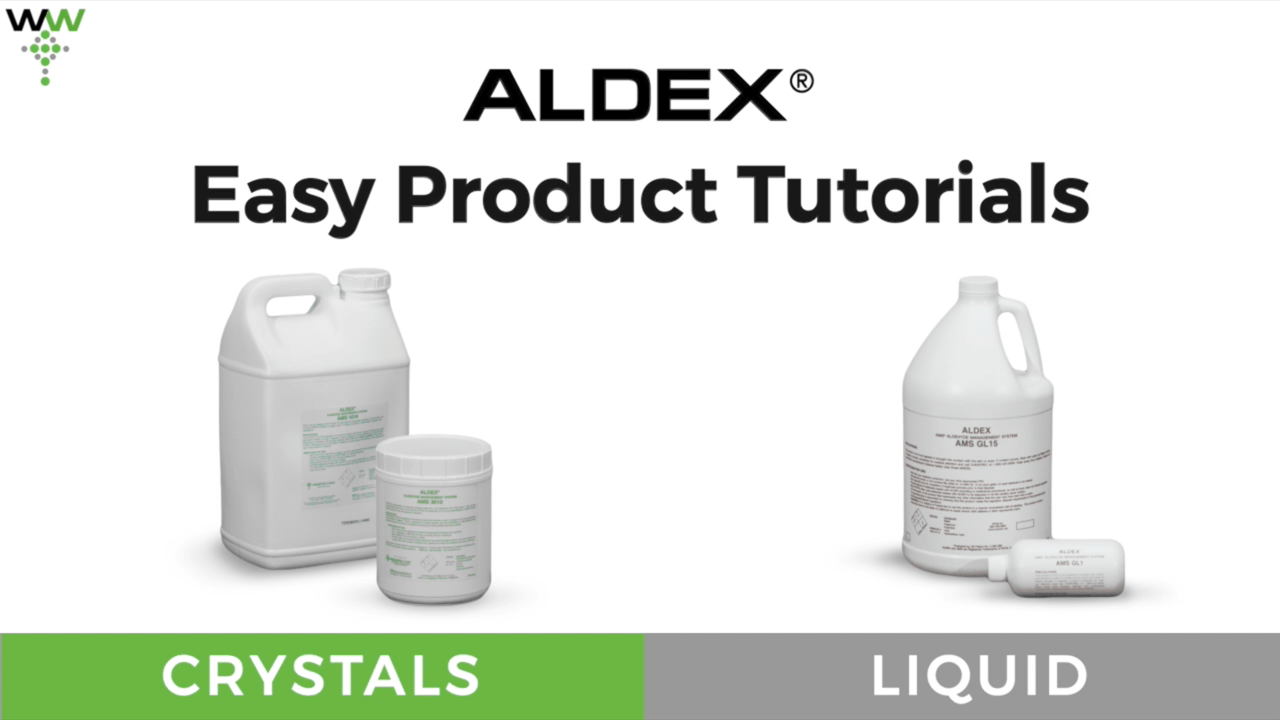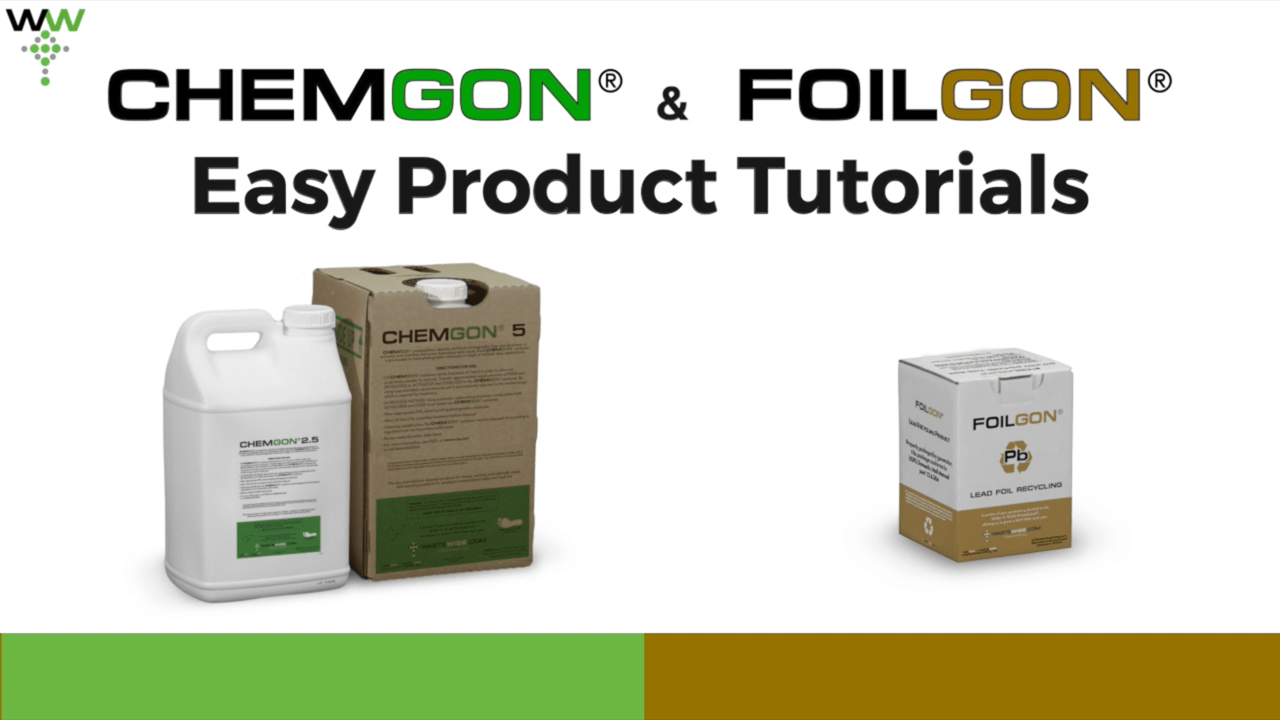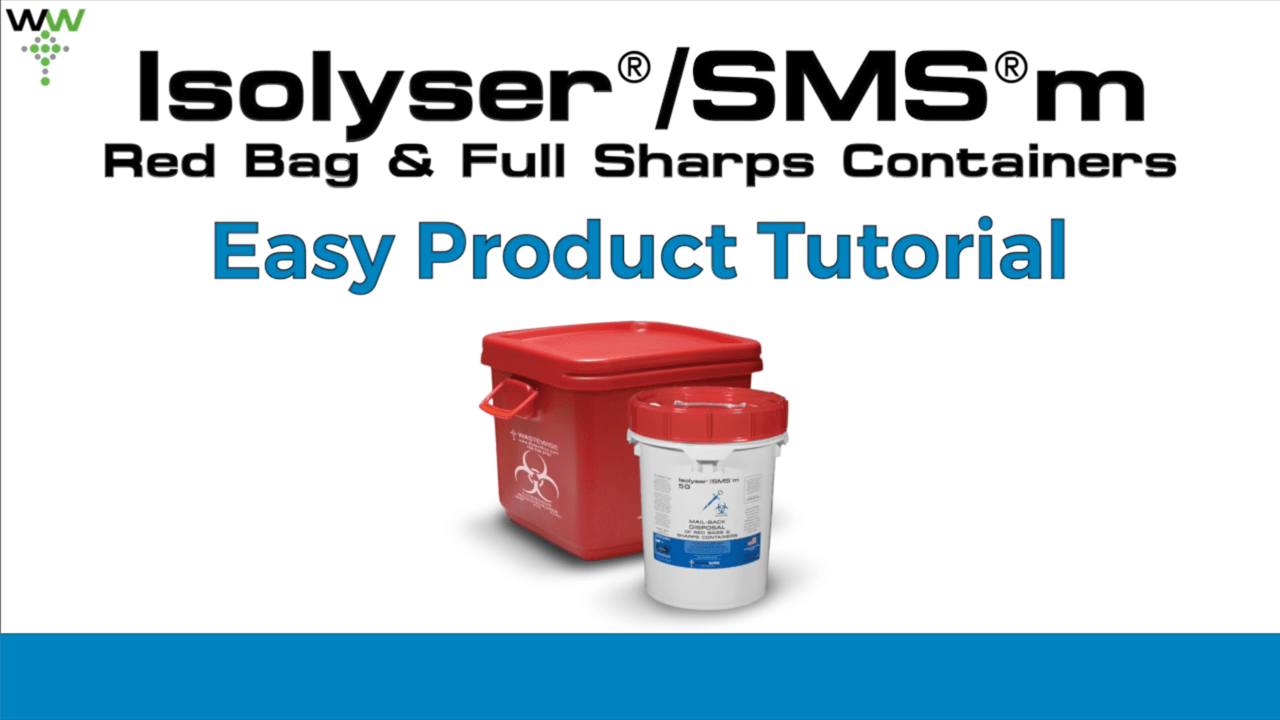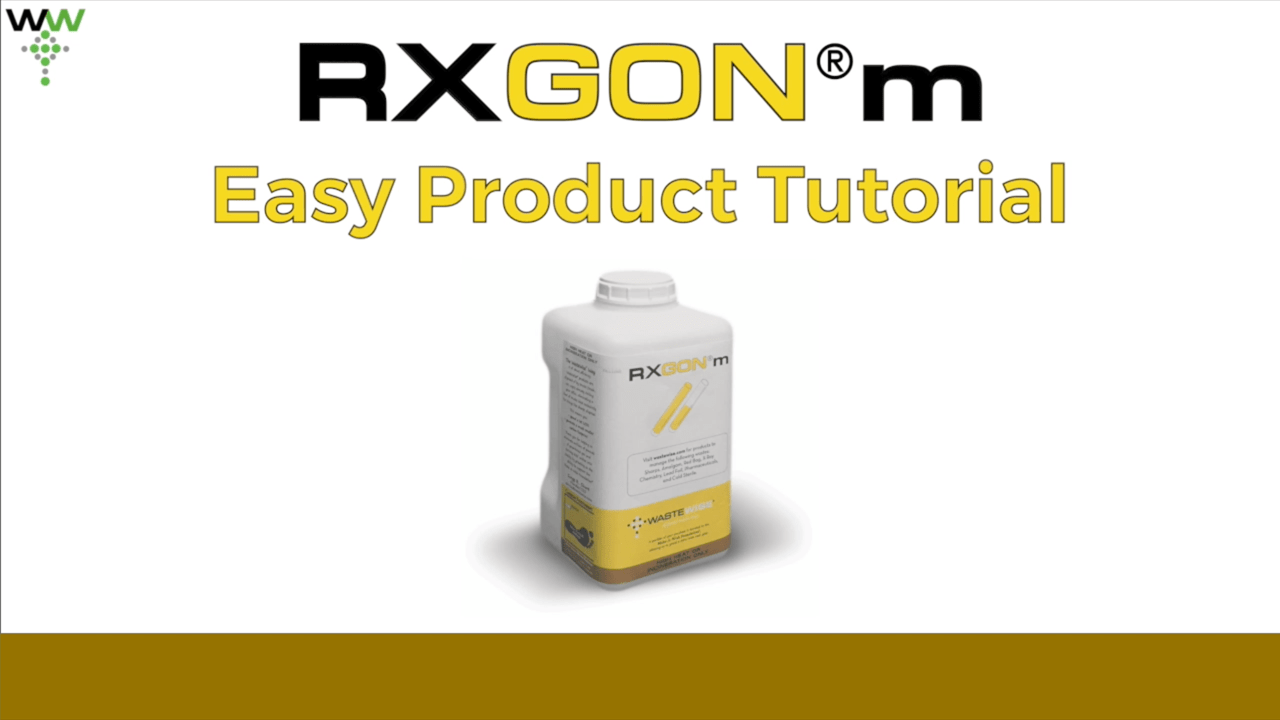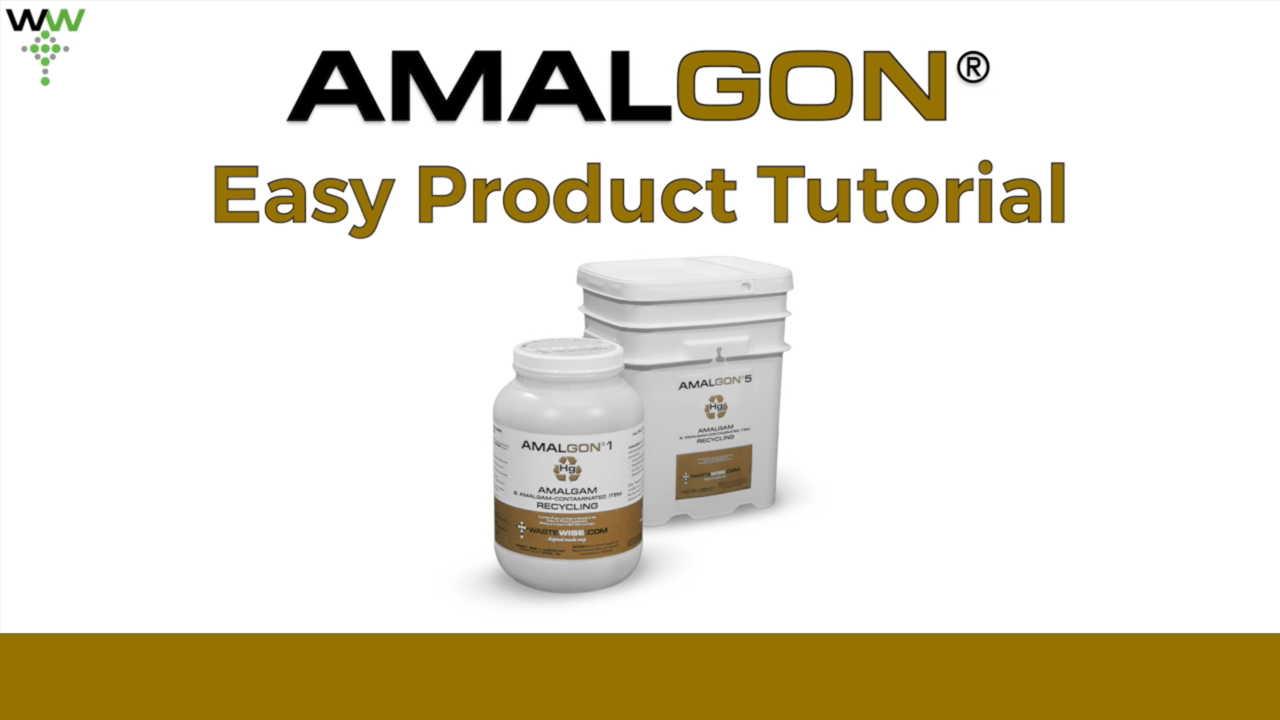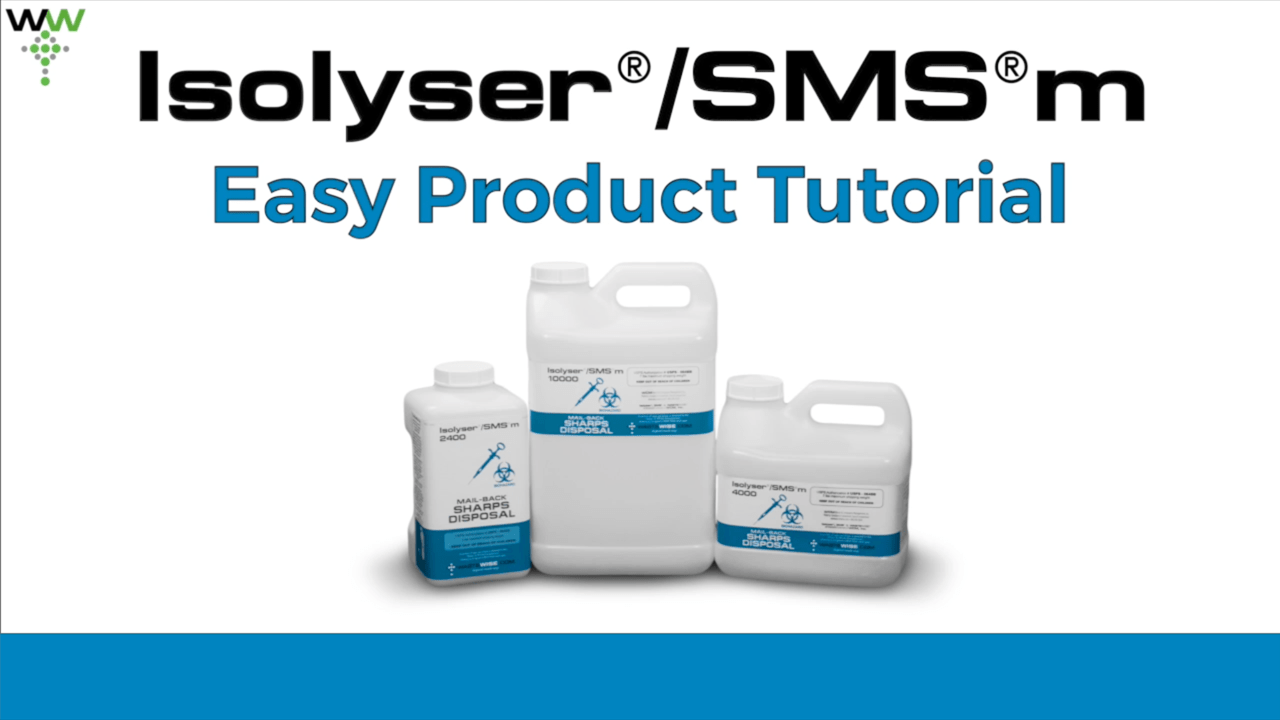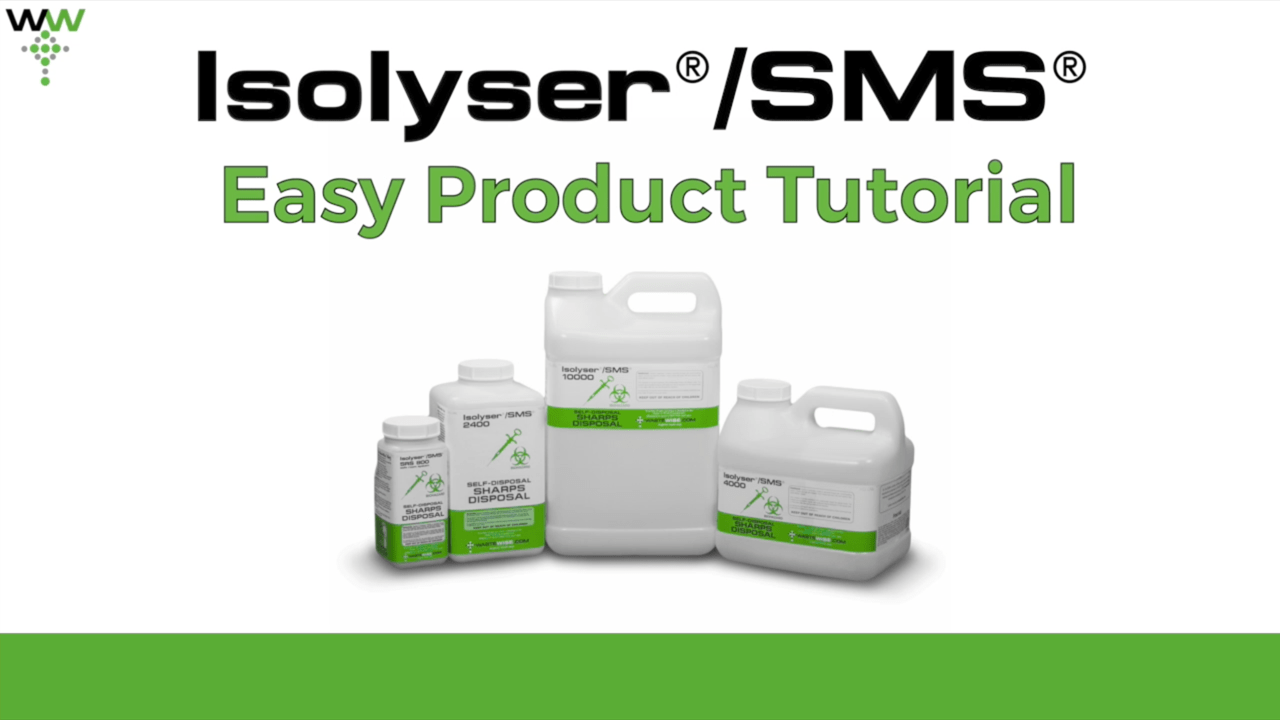Frequently Asked Questions
You can find the answers to many common questions about our products and services below in convenient categories. You can use the search box with specific topics or keywords to quickly find the right answer.
Scratcher Card
- What is the Scratcher Card, and how does it work?
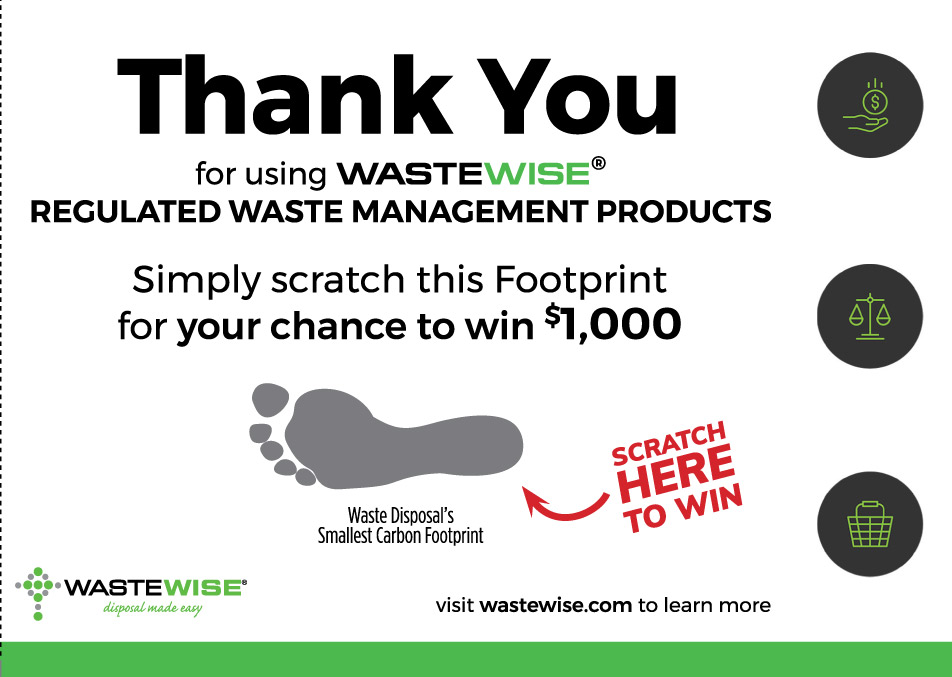
As a “Thank You” to our customers, we include a scratch-off card in most WasteWise products. Prizes range from a Starbucks Gift Card to $1,000 in Cash. Simply scratch the covering from the grey foot to see if you have a winning card. $1,000 winners must send WCM a picture and allow it to be used in future marketing materials in order to collect $1,000.
Send winning cards to WCM, Inc. c/o Scratcher Card, at 6054 Corte del Cedro, Carlsbad, CA 92011. Cards must be received before the expiration date printed on the back of each card.
Available to legal residents of 50 United States (DC), 18 years and older. Void where prohibited. WCM reserves the right to reject a winning ticket for any reason. Promotion ends as of date noted on card. Overall odds of winning a prize are a minimum of 1:8. If Federal or state income requirements requires us to report income we must comply.
If you have questions, call us at 866-436-9264 or email us at info@wastewise.com.
Aldex Aldehyde Disposal
- What is Aldex?
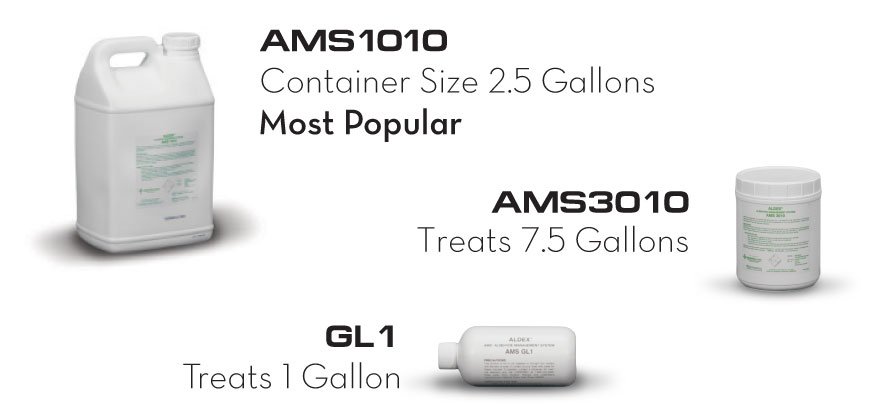
Aldex/AMS Aldehyde Management System neutralizes Aldehyde wastes such as Glutaraldehyde, Formalin and Formaldehyde.
- Why is Aldex the best choice for onsite Aldehyde treatment?Aldex is the most concentrated neutralizer available for aldehyde treatment. In a side-by-side comparison, our patented formula effectively neutralizes TWO to THREE TIMES the amount of Aldehydes using the same amount of product. This means you save nearly 50% per treated gallon compared to other neutralizing products. Aldex neutralizer is simply the most convenient, safe, time and money-saving Aldehyde waste management method available. In addition, the United States EPA has directed onsite generators to use Aldex like solutions to neutralize their Aldehyde waste before disposal.
- How does Aldex work?
Aldex neutralizes and crosslinks used 10% formalin (or up to 4% glutaraldehyde), and converts the liquid into a non-toxic, non-hazardous waste. Once neutralized, it is safe to dispose of treated waste either down the drain using our liquid neutralizer or in your regular trash using our crystalline/powder neutralizer.
- How do I use Aldex?
Two different neutralizing formulas are available; liquid and crystalline. To use the liquid version, read and follow directions on the container. Add 1 part Aldex liquid to 15 parts Aldehydes. For example, the GL1 (8) ounce bottle neutralizes (1) Gallon of Aldehydes. After mixing is complete and sufficient time has passed, the neutralized liquid is safe for drain disposal. To use the crystalline version, read and follow directions on the container. For the AMS1010, simply pour Aldehydes in the 2.5 Gallon container. The patented powder neutralizes and solidifies the liquid, making it safe for regular trash disposal. Additional Aldehydes may be added over time. Both liquid and crystalline products are available in several sizes and can be used for spill clean-up or bulk neutralizing.
- What are the benefits of using Aldex?
- Reduce disposal cost by 50%, or more compared to hazardous waste pick-up company prices – lowest available cost per gallon.
- More convenient than storing waste waiting for old style waste pick-up company.
- Reduces potentially hazardous vapors associated with Aldehydes by neutralizing them immediately versus storing vapor-emitting waste waiting for a pick-up.
- Helps you exceed OSHA standards for exposure.
- Order from your supply company; no contracts, separate invoices and unnecessary interruptions for waste collection.
- Is Aldex acceptable for use in my state?Yes, although a treatment permit may be required. Check your local regulation or call us for help. Water districts have authority concerning effluent disposal. We are unaware of any State or water district that does not allow generators to neutralize Aldehydes with Aldex.
- Is Aldex acceptable for use in California?Aldex may be used to neutralize formalin and formaldehyde in the State of California. Hazardous glutaraldehyde waste must be treated before disposal. Treating less than 55 gallons of hazardous glutaraldehyde waste per month requires a Conditionally Exempt Small Quantity Treatment (CESQT) permit; treating more than 55 gallons per month would require a Permit by Rule (PBR). Both types of permit are issued by your local Certified Unified Program Agency (CUPA) (See “How do I get a permit in California?” below). Annual permit fees are less than collection costs and treating in office with the Aldex reduces the liability associated with collection/transportation of hazardous aldehyde wastes. For formaldehyde and formalin wastes, the State of California has eliminated its certification process for neutralizers due to budget constraints and has advised us that there are currently no “certified” aldehyde neutralizer products available in the State; therefore, all generators should obtain a permit before using any neutralizer including Aldex. The State of California also allows for the use of Aldex to treat non-hazardous glutaraldehyde waste without a permit. Call us for help regarding California or read on; glutaraldehyde waste degrades after activation and most likely will become non-hazardous within the allowed hazardous waste accumulation time. Generators should contact their glutaraldehyde product manufacturer for degradation time information to determine when their glutaraldehyde formula will become non-hazardous. As long as the degradation occurs unaided by the generator (i.e. no addition of heat, chemicals other than glycine, aeration or otherwise), and it occurs within the generator’s allowed accumulation time, and the degraded glutaraldehyde waste is no longer hazardous as determined by the generator, the generator can then use Aldex without a permit to safely dispose of their waste.
- How do I get a permit in California?To apply for a hazardous waste treatment permit or “Standardized Permit” to treat aldehydes in your office using Aldex, generators located in California should visit the California Certified Unified Program Agency (CUPA) directory here: http://cersapps.calepa.ca.gov/Public/Directory/. Once there, click on “County” to find the contact for your area. Contact your county CUPA and ask for the hazardous waste specialist responsible for generator authorization for onsite treatment of this hazardous waste.
Foilgon Lead Foil Recycling
- What is Foilgon?
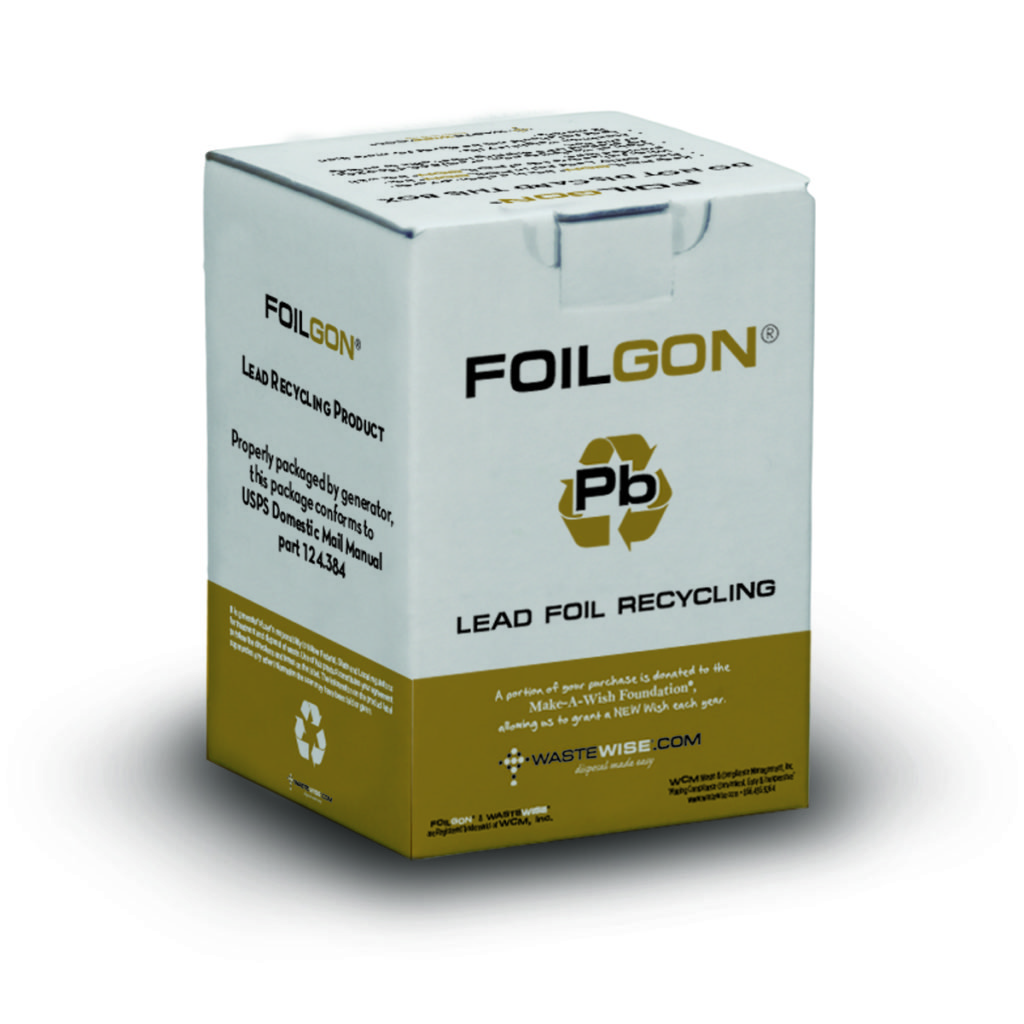
Foilgon is our lead foil recycling product. Lead foil from exposed x-ray film is hazardous and cannot be thrown in the regular trash.
With Foilgon, you get everything you need to properly manage lead waste.
- How does Foilgon work?
- How do I use Foilgon?
Simply order Foilgon from your supply company, or order from us and we'll pass it to your Supply Rep. Open the box and follow directions on inside lid of the box. Place your lead foil in the Foilgon container (no more than 7lbs. per Foilgon container). When Foilgon is full, simply attach prepaid UPS return shipping label to the side of the box and give the entire container to your UPS driver. The container will be delivered to our recycling facility.
- Can we use Foilgon to recycle lead aprons?Because lead aprons include other materials, they may not be recycled using Foilgon. Please check with your lead apron supplier or manufacturer for recycling options.
Chemgon X-Ray Chemical Disposal
- What is Chemgon?
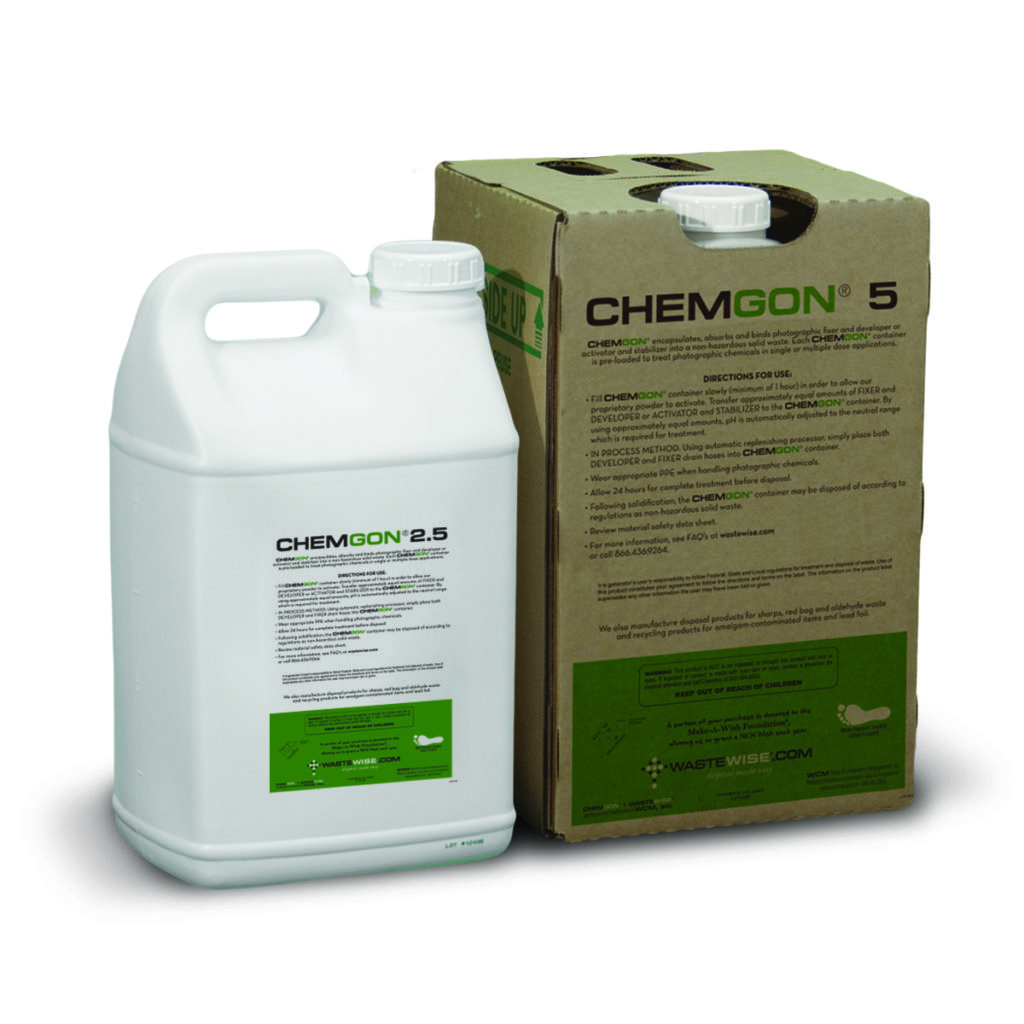
Chemgon is a patented formula that converts hazardous, silver-laden x-ray and photo processing fluids into a non-hazardous solid, safe for disposal with regular trash.
- How does Chemgon work?
Chemgon solidifies, encapsulates, chelates, absorbs and binds processing chemicals through the application of coordination chemistry, converting your hazardous liquid waste into a non-hazardous solid waste safe for regular trash disposal. Standard toxicity testing (Toxicity Characteristic Leaching Procedure, TCLP) demonstrates that waste treated with Chemgon test below the regulatory levels established by the EPA. Chemgon treated waste results in a nonhazardous, non-biodegradable solid waste, safe for regular trash disposal.
- How do I get a hazardous waste treatment permit in California?To apply for a hazardous waste treatment permit or ‘Standardized Permit’ to treat hazardous silver fixer/activator waste in your office using Chemgon, generators located in California should visit the California Certified Unified Program Agency (CUPA) directory here: https://cersapps.calepa.ca.gov/Public/Directory/. Once there, click on County to find the contact for your area. Contact your county CUPA and ask for the hazardous waste specialist responsible for generator authorization for onsite treatment of this hazardous waste.
- Do I need to treat my fixer or photographic chemistry before disposal?YES. The concentration of silver in used photo-processing chemicals is typically between 160-350 Parts per Million (PPM). Mixing with developer reduces the silver PPM by nearly half, between 80 – 175 PPM. The Federal EPA Hazardous Waste RCRA Regulations define hazardous amounts of silver as greater than 5 PPM. This means used, untreated processing chemicals are hazardous. Spent processing waste treated with Chemgon® reduces the PPM below the regulatory limit of 5 PPM and converts it from a liquid to a “solid” non-pourable, non-hazardous waste, safe for regular trash disposal. See EPA Document Table 1. Fines for improper disposal could be as much as $22,000 PER OCCURRENCE. In other words, each time silver-laden processing chemicals or silver reclamation unit liquid residue wastes are poured down the drain, the fine could cost you $22,000.
- How many Chemgon containers can I fill each month and still be considered a Small Quantity Generator (SQG)?In order to be considered an SQG, you must not generate more than 220 lbs. of waste each month. Therefore, you can fill ten (10) Chemgon containers each month. Fixer weighs about (8) lbs. per gallon, so (25) gallons of fixer is the approximate threshold. Since fixer is mixed in equal parts with developer (non hazardous liquid waste) you can utilize (10) Chemgon containers for a total of 50 gallons of fixer/developer each month and still be considered an SQG. Small Quantity Generators are usually exempt from obtaining a treatment permit.
- How do I use Chemgon?
Simply pour equal amounts of fixer and developer into the Chemgon container. Because the patented polymer is highly absorbent, the container may be filled a little at a time over many months. This means it is not necessary to stage or store chemicals separately. Once full, tighten the lid and place in your regular trash. Equal parts of fixer and developer are needed to create a neutral pH; a neutral pH is required for proper treatment and solidification to occur.
Watch our Easy Product Tutorial for Chemgon.
- What are the benefits of using Chemgon?
- Save up to 75% compared to a hazardous waste collection company.
- More convenient than hazardous waste pick-up or silver recovery; simply fill over time and dispose of the solidified contents when full.
- Order from your supply partner and eliminate a separate vendor, contracts, extra invoices and unnecessary interruptions for waste collection.
- I understand equal parts fixer and developer must be added to Chemgon. We only have fixer, what should we do?Purchase new developer to mix with your spent fixer. Pour equal amounts of the “new” developer and spent fixer into the Chemgon container. While we prefer not “wasting” new developer, this approach is less expensive and better for the environment than using a waste collection company.
- What products are not for use with Chemgon?Electrostatic chemistries, fountain solutions, etches and blanket washes should not be used with the Chemgon product.
- Can Chemgon be used in all states?Yes, Chemgon can be used in all 50 states. California is the only state we are aware of that requires Small Quantity Generators to obtain a hazardous waste treatment permit to treat silver-laden photo-processing waste, with Chemgon.
- What testing has been done to verify the effectiveness of Chemgon?Representative photo-processing/x-ray waste treated with Chemgon is converted to a non-hazardous solid waste when measured using the following tests: Toxicity Characteristic Leaching Procedure (TCLP) for metals, Paint Filter and the California 96-Hour Acute Aquatic Toxicity test (“Fish Test”).
- Who is responsible for the "Determination of Hazardous Waste"?The generator is responsible for "determination of hazardous waste," meaning they decided whether their waste is hazardous or non-hazardous. (See Code of Federal Regulations Title 40 CFR 262.11) Federal Regulations allow generators to make that determination by either testing via Toxicity Characterization Leachate Procedure (TCLP); or applying knowledge of the hazard characteristic in light of the materials and/or the processes used. This means you have the option to use documented waste analysis results of treatment, such as our testing results . Click here for Federal Regulations regarding maximum allowable concentration for silver in TCLP results: 40 CFR 261.24 Toxicity Results Table 1
- What is general or acceptable knowledge?Acceptable knowledge is broadly defined to mean an understanding of the resulting hazardous characteristic of the waste in light of the materials used and/or the treatment process used, including film processing waste test results post-treatment. Knowledge of the hazardous characteristic of film processing waste post-treatment can include detailed information about the waste obtained from existing or documented waste treatment analysis and/or studies conducted on wastes generated by processes similar to that which generated the waste in question. This means your “Acceptable Knowledge” includes TCLP toxicity test results provided by the manufacturer for the treatment product used. Click here for toxicity testing results of film processing waste treated using Chemgon: TCLP Reference: 40 CFR 262.11 (c)(2)
- Where can I get a Chemgon SDS (Safety Data Sheet)?You can find the Chemgon SDS (Safety Data Sheet) here.
Isolyser/SMSm Red Bag Disposal
- How do I handle bloody gauze or red bag medical waste?The generally accepted standard for identifying medical waste is to answer the following question: “Is the item saturated to the point where it would drip if compressed?” If the answer is “no,” the waste is not considered biohazardous, and may be disposed in your regular trash. If your office does generate medical waste, Isolyser/SMSm Red Bag disposal products are your best option for disposal. Order from your supply company and follow directions included with each kit.
- What is the Isolyser/SMSm Red Bag and Sharps Containers Mail-back disposal system?
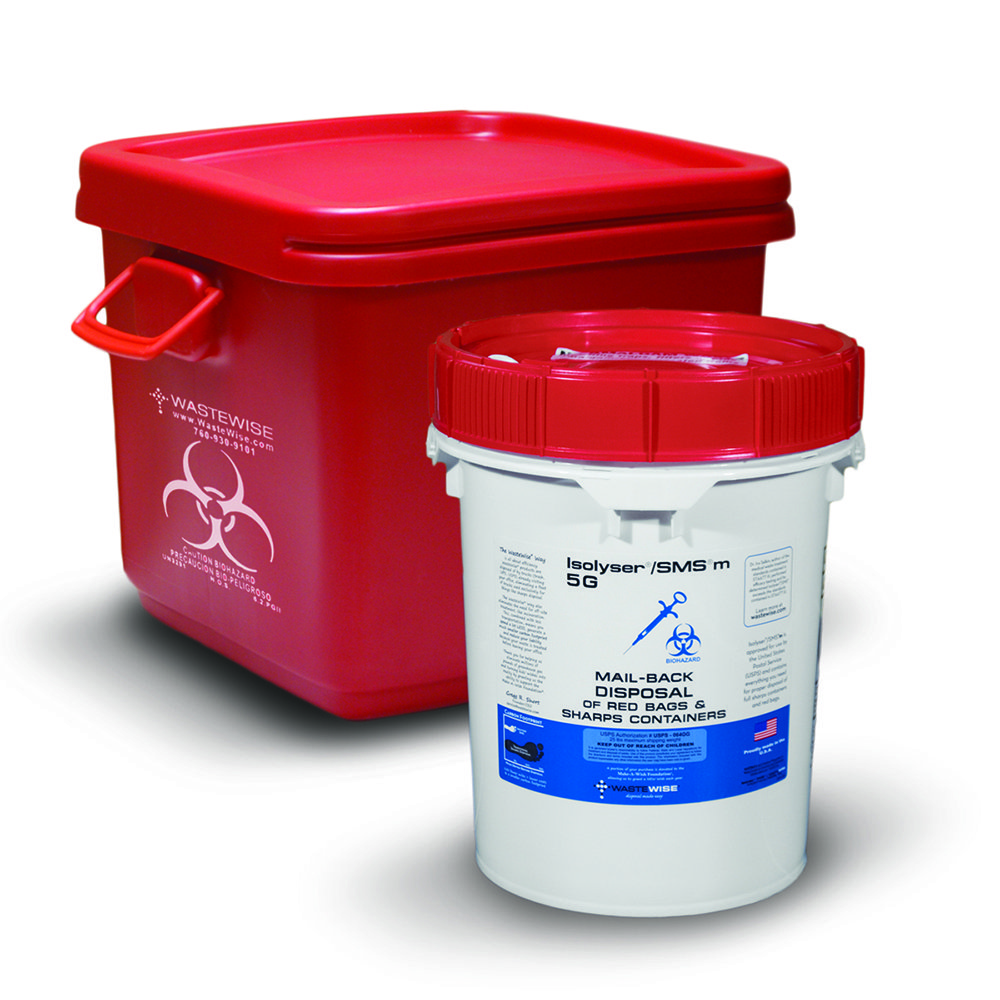 Isolyser/SMSm Red Bag is the most convenient and cost-effective way to dispose of red bag medical waste and full sharps containers. Each product includes: storage container, prepaid return postage, treatment and disposal. Simply fill, package, and give to your regular Postal worker. We offer two sizes: 5 gallon and 18 gallon sizes. Learn more about Isolyser/SMSm Red Bag
Isolyser/SMSm Red Bag is the most convenient and cost-effective way to dispose of red bag medical waste and full sharps containers. Each product includes: storage container, prepaid return postage, treatment and disposal. Simply fill, package, and give to your regular Postal worker. We offer two sizes: 5 gallon and 18 gallon sizes. Learn more about Isolyser/SMSm Red Bag
RXGONm Pharmaceutical Disposal
- How does RXGONm work?
RXGONm is for disposal of full and partially full dental anesthetic carpules, as well as unwanted pharmaceuticals. When your RXGONm container is full, print the shipping label from our website, attach it to the shipping box and give it to your UPS driver or drop it off at a UPS drop-off location. Broken carpules are sharps waste and may NOT be placed in RXGONm, use Isolyser/SMS or Isolyser SMSm for proper disposal.
- What kind of pharmaceutical waste can be placed in RXGONm?
- How do I order RXGONm for my practice?
- Why is RXGONm better than hiring a waste pick-up company?RXGONm is less expensive (about 1/3 the cost) and there are NO contracts to sign or hidden fees! Waste pick-up companies use antiquated systems, including large trucks dedicated to a single job i.e. collecting, transporting, treating and disposing of relatively small amounts of pharmaceutical waste. By comparison RXGONm is disposed of using the UPS truck already visiting your office, it’s a more efficient and environmentally-friendly way to dispose of carpules and unwanted pharmaceuticals.
Amalgon Amalgam Recycling
- How does Amalgon work?
Amalgon amalgam recycling product is used to properly manage amalgam-contaminated items. Simply fill the container with amalgam-contaminated waste. Attach the pre-paid shipping label and give your full container to the UPS driver or drop it off at a UPS drop-off location. Chair-side vacuum traps should be placed in the Amalgon container. Chair-side vacuum traps should NOT be put in the regular trash, a red bag or rinsed in the sink. Amalgon will be shipped to our EPA licensed processing facility. The amalgam contaminated items are processed. The mercury is separated and recycled.
- What kind of amalgam contaminated waste can be recycled using Amalgon?
The following amalgam contaminated waste items may be returned for processing: chair-side traps, vacuum pump filters, screens, amalgam capsules, non-infectious teeth with amalgam restorations and scrap amalgam. It is not necessary to sort or separate Contact from Non-Contact amalgam before placing these items in the Amalgon container.
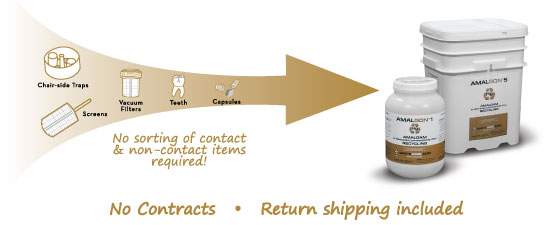
- Do I need Amalgon?
Every office that removes or places amalgam fillings needs Amalgon. In other words, virtually EVERY dental office needs Amalgon. If you are disposing of or rinsing your chair-side vacuum traps out in the sink or trash you are improperly disposing of hazardous waste. With Amalgon, hazardous mercury, is recycled. Use Amalgon to dispose of Chair-side traps, vacuum filters, screens, capsules, amalgam-contaminated teeth and scrap amalgam. Click here: ADA’s Statement on Dental Amalgam

- Are we required to disinfect amalgam waste before placing it in the Amalgon container?
Amalgam contaminated items like chair-side traps, screens and filters should be placed in the Amalgon container after you have performed routine vacuum line cleaning/maintenance per vacuum system manufacturers specifications. Teeth placed in the Amalgon container must be non-infectious. As long as no ‘tissue’ is attached to the tooth, it’s generally accepted the tooth is non-infectious.

- Do we need to separate Contact and Non-Contact amalgam when using Amalgon?
Amalgon is unique, there is no sorting required, both contact and non-contact amalgam may be placed in your Amalgon container.
You save time by not having to separate contact and non-contact amalgam contaminated items. You also save valuable space by eliminating the need for two separate storage containers, one for contact and another for non-contact amalgam contaminated items.
Order Amalgon from your supply company and take advantage of this significant difference today!

- What type of amalgam waste can be placed in the Amalgon container?
Only amalgam and amalgam-contaminated items may be placed in the Amalgon container. This includes chair-side traps, vacuum filters, screens, capsules, amalgam-contaminated teeth and scrap amalgam. Elemental Mercury may not be placed in the Amalgon container. Call us for information about recycling bulk mercury.

- Do you accept whole filters from the vacuum pump for recycling in the Amalgon container?
Yes. Use Amalgon to properly dispose of vacuum pump filters, chair-side traps, screens, teeth, and capsules.

- Do you pay for clean non-contact (scrap) amalgam?No, we do not pay for scrap amalgam. For the convenience of our customers we provide a mixed amalgam waste recycling solution in our Amalgon product. The cost of sorting and removing amalgam from filters, traps, screens and teeth far exceeds the value of recovered mercury.
- What is the correct way to dispose of Chair-side traps?
Follow these directions to correctly dispose of chair-side traps using Amalgon.
- Remove disposable chair-side evacuation trap and place directly into the Amalgon amalgam recycling container.
- Do not clean disposable traps under running water or discharge amalgam into the waste water system.
- Do not put evacuation traps or its contents into sharps container, red biomedical bag, regular trash or rinse in the sink, sending hazardous contents down the drain.
- Does your company have applicable license and proper forms required by the EPA and State agencies for metals recovery?Yes, our recycling site retains all licenses and permits for metals recovery. Upon request, a certificate of recycling can be provided. Retain the tear-off portion of the UPS label as a tracking document and proof of recycling; and use our Disposal and Recycling Log to document recycling activities. Click here to download a copy for your records: Disposal & Recycling Log
- I have an amalgam separator, do I also need Amalgon, and what do I do with my used separator filter/cartridge?
An amalgam separator is used in conjunction with Amalgon, so YES you need Amalgon. The separator filter/cartridge catches the invisible amalgam dust in your vacuum line effluent preventing mercury pollution from entering our drinking water. The amalgam separator filter/cartridge must be exchanged per manufacturer directions. Once exchanged the used filter/cartridge must be returned to the amalgam separator manufacturer. Typically the separator manufacturer will send you a new filter/cartridge upon receipt of your spent filter/cartridge. Use Amalgon for contact and non-contact amalgam, your chair side traps, vacuum pump filters, screens, capsules, amalgam-contaminated teeth and scrap amalgam. By using an amalgam separator, and regularly changing the filter, in conjunction with Amalgon you eliminate the possibility of mercury entering our environment.

Isolyser/SMSm Mail-Back Sharps Disposal
- Are wall or cabinet mounts available?
Yes, locking wall mount units are available for the following products and sizes:
- Isolyser/SMS Sizes:
- SRS800: WMU800 wall mount unit
- 2400: WMU2400 wall mount unit
- 4000: WMU4000 –wall mount unit
- Isolyser/SMSm Sizes:
- 2400m: WMU2400 wall mount unit
- 4000m: WMU4000 –wall mount unit
- RXGONm Sizes:
- WMU2400 wall mount unit
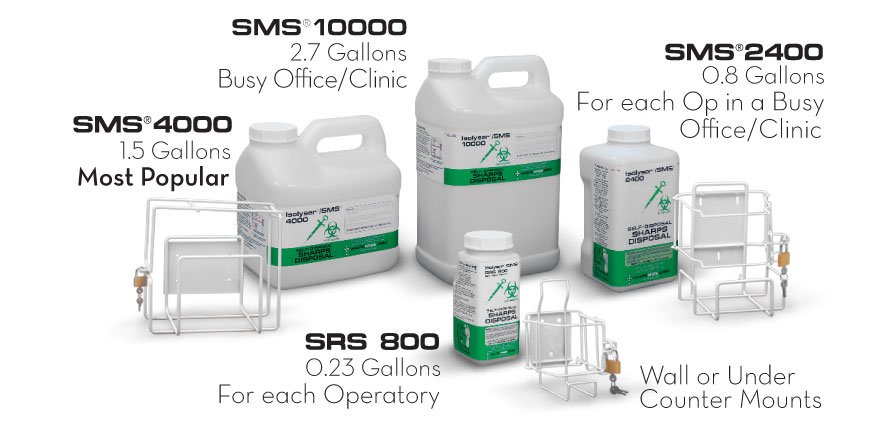
Isolyser/SMS Sharps Disposal 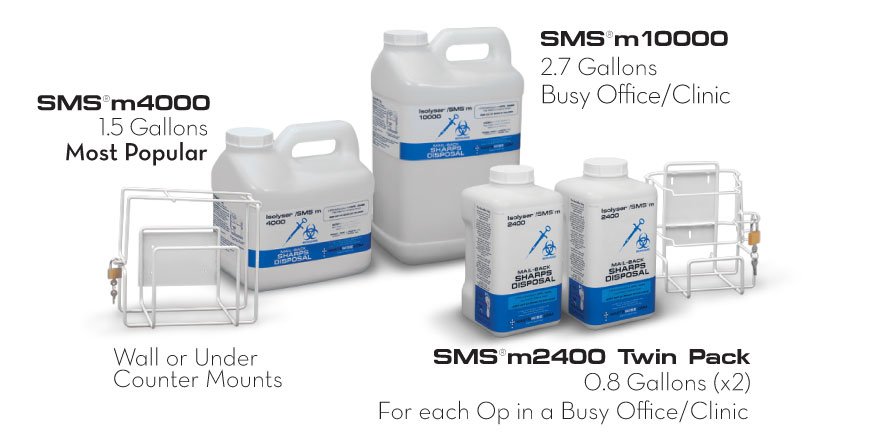
Isolyser/SMSm Mail-back Sharps Disposal 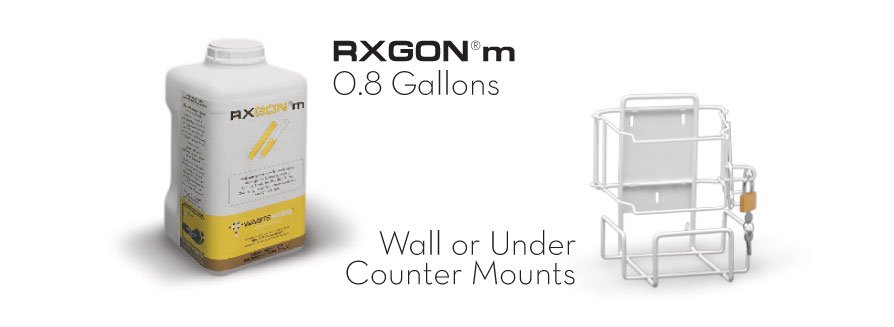
RXGONm Pharmaceutical Disposal - Isolyser/SMS Sizes:
- What is the Isolyser/SMSm Mail-back Sharps Disposal System?
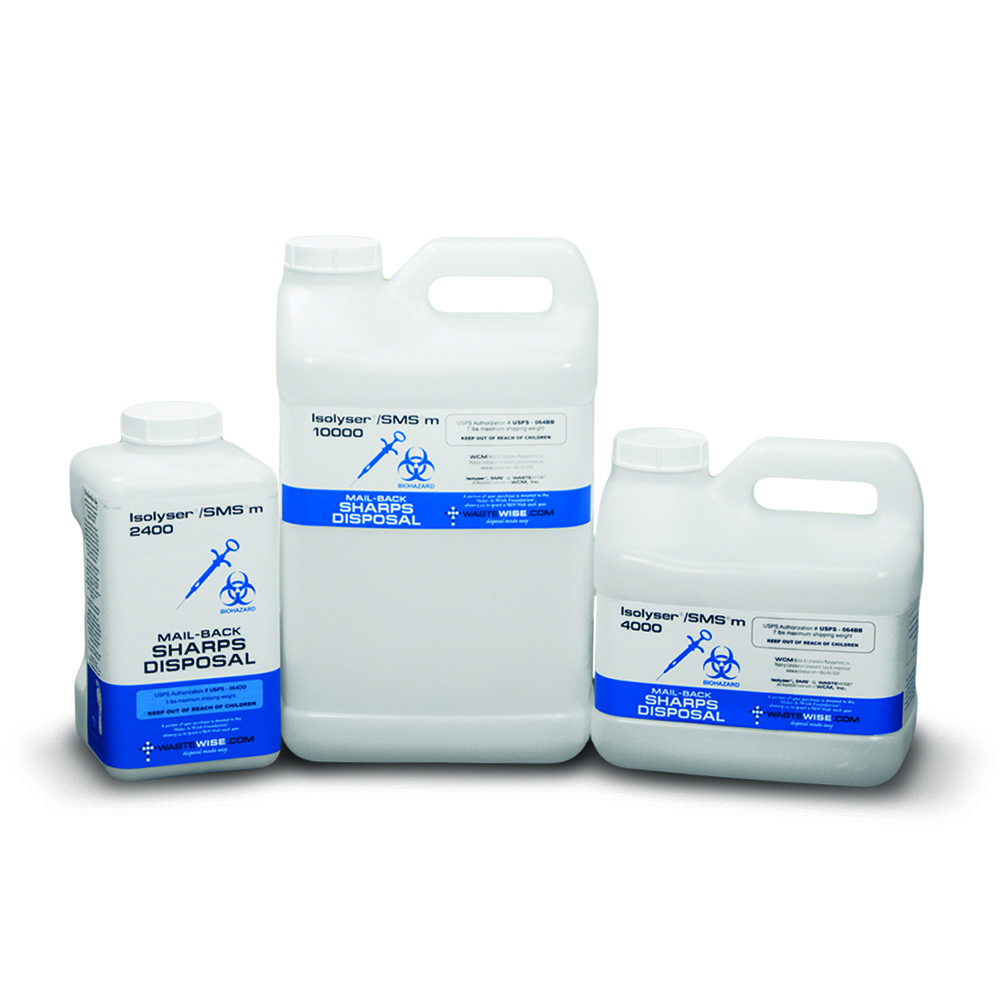
Isolyser/SMSm Mail-back Sharps Disposal is the most convenient and cost-effective way to dispose of sharps or small amounts of red bag medical waste. Each product includes: sharps storage container, prepaid return postage, treatment and disposal. No waste collection service is needed. Simply fill, package, and give to your regular Postal worker.
- How does Isolyser/SMSm work?
Isolyser/SMSm Mail-back Sharps Container completely replaces the expensive and outdated sharps disposal waste pick-up company. Simply order from your supply company and place needles, syringes, other sharps and red bag medical waste in the Isolyser/SMSm Mail-back Sharps Disposal container. When full, package the container as instructed and give to your mailman. The US Postal Service will deliver your package to us for treatment and disposal. Isolyser/SMSm is the ideal product for Medical, Dental and Veterinary offices.
Watch our Easy Product Tutorial to learn more.
- How do I order Isolyser/SMSm for my practice?
Order Isolyser/SMSm Mail-back Sharps Disposal from your regular supply company. A partial list of our distribution partners is available here.
- Why is Isolyser/SMSm better than hiring a sharps disposal waste pick-up company?Sharps disposal waste pick-up companies use antiqued systems, including large trucks dedicated to a single job i.e. collecting, transporting, treating and disposing of relatively small amounts of sharps waste. By comparison Isolyser/SMSm is disposed of using the mail truck already visiting your office. It’s a more efficient and environmentally friendly way for sharps disposal.
Isolyser/SMS Sharps Disposal
- What is Isolyser/SMS Sharps Management System?
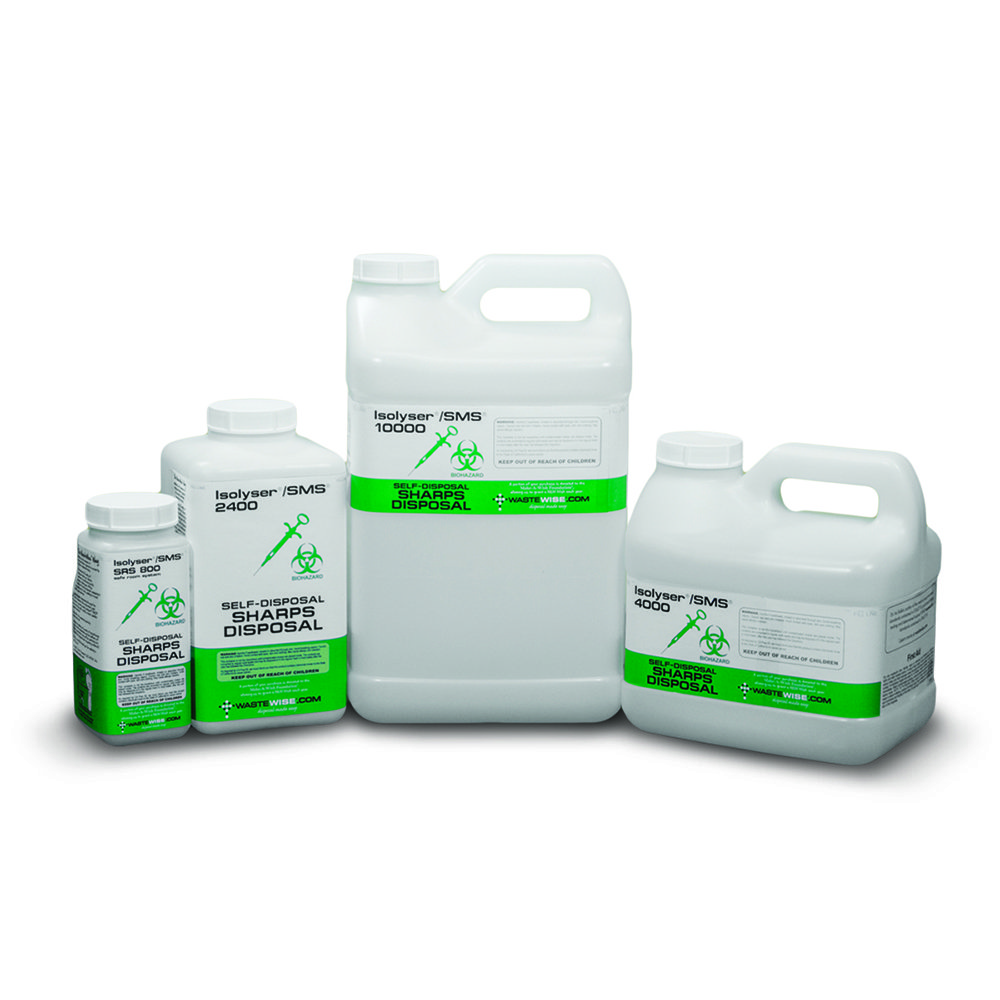
Isolyser/SMS Sharps Disposal is a sharps treatment and disposal product used to properly dispose of needles, syringes, blades and other potentially infectious sharps directly in your office. Since 1989, thousands of medical, dental and veterinary offices have safely used Isolyser/SMS to store, treat and dispose of sharps.
- How does Isolyser/SMS work for sharps disposal?
Using Isolyser/SMS for sharps disposal is easy. Place needles, syringes, blades, endo files, broken carpules and other sharps in the Isolyser/SMS container, which is pre-filled with our patented liquid monomer. When full, add the two catalyst packets. This will activate the monomer, generate heat and solidify the sharps into a solid polymeric matrix. Once solidified, the sharps are treated and encapsulated; rendered non-biohazardous, unrecognizable, unusable, and safe for disposal in the regular trash.
Watch our Isolyser/SMS Easy Product Tutorial to learn more.
- What are the key benefits of using Isolyser/SMS for sharps disposal?There are many benefits to using Isolyser/SMS for sharps disposal:
- Safer – untreated sharps never leave your office
- Easier – order and pay for Isolyser/SMS along with your regular medical supplies
- Save 70% – use the savings to buy new equipment
- No Contracts – ever
- Smallest Carbon Footprint – 100 fewer miles driven, per sharps container, before disposal
- Give Back – Your purchase supports the Make-A-Wish Foundation®
- How do I purchase Isolyser/SMS?
- Why is Isolyser/SMS better than hiring a waste disposal pick-up company?
Traditional waste disposal pick-up companies use antiquated systems, including large dedicated trucks that generate a tremendous amount of pollution to collecting sharps waste. Couple that with the pollution associated with treating relatively small amounts of regulated waste and ultimately driving it to a disposal site and its easy to see there are many wasteful and expensive efficiencies in this process. The average sharps container is driven 100 miles BEFORE its treated and then another 50 miles to a disposal site. By comparison Isolyser/SMS is disposed of using transportation vehicles already visiting your office. Isolyser/SMS containers are driven about 50 miles before disposal, about 100 fewer miles per sharps container.
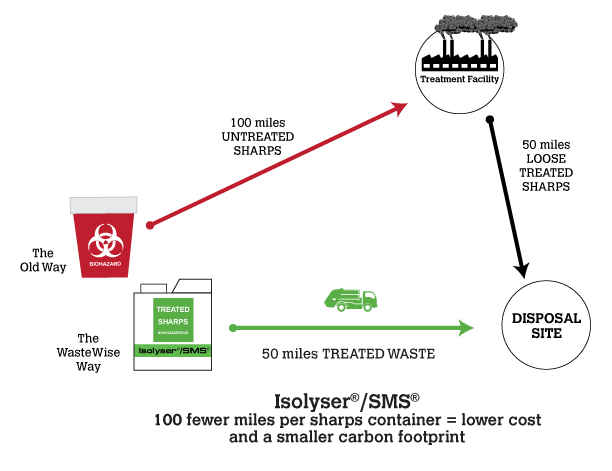
- Is the Isolyser/SMS Sharps Management System approved for use in my state?
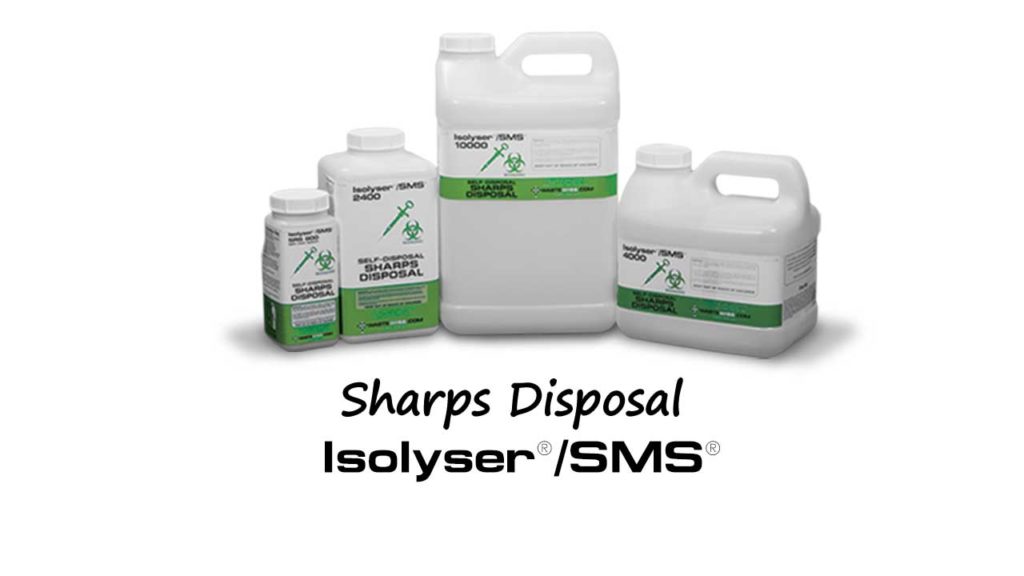
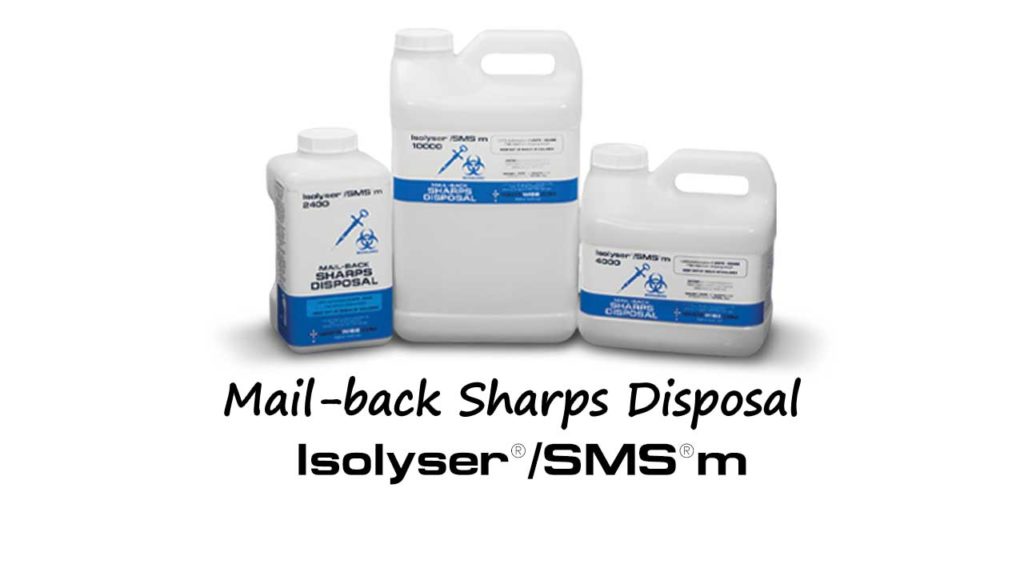
YES, Isolyser/SMS or Isolyser/SMSm may be used in ALL 50 states; either by State Approval, Approval by Rule, Generator Application, Generator Obtained Permit or by using our Isolyser/SMSm Mail-back Disposal Products. Disposal of activated Isolyser/SMS containers as “regular” office trash is allowed in the following States: AK, AL, AZ, AR, CA, CO, GA, HI, ID, IL, IN, IA, KS, KY, LA, MA, MI, MO, MS, MT, NE, NM, NV, NC, ND, OH, OK, PA, SC, SD, TN, TX, UT, VT, WA, WI, WV, and WY.
- Our waste collection company says we're under contract. What options do we have?
Disposal contracts may include a provision for early termination. This provision may also include an early termination fee. Even if you must pay a fee to switch to Isolyser/SMS, most customers will save more than enough money to recoup the fees within the 1st year. There are NO contracts with WasteWise products; our Customers use them because they want to.

- What should I do if my Isolyser/SMS container doesn't solidify per the directions?Do not worry, we can help. Please call us at 866-436-9264 and we'll be happy to assist you.
- What is a Prop 65 Warning?Prop 65 Warning refers to a 1986 initiative approved by California voters. The law requires businesses to notify Californians if their products contain any of the 800 chemicals named by the State of California known to cause cancer or reproductive harm. These warnings appear at all gas stations, grocery stores and even places like Starbucks Coffee. As required by California Prop 65, we must inform you that our product contains chemicals known to the State of California to cause cancer. Click here for a complete list of chemicals included on the list: https://oehha.ca.gov/proposition-65/proposition-65-list. Note that a Prop 65 warning does not mean a product is in violation of any product safety standards or requirements. For more information, visit the California Office of Environmental Health Hazard Assessment website.
- Where can I find the Isolyser/SMS Safety Data Sheet (SDS)?You can download the Isolyser/SMS Safety Data Sheet (SDS) HERE.
- I misplaced my Isolyser/SMS catalyst packets, what do I do?That is not a problem. You can easily order replacement Isolyser/SMS catalyst packets from your supply company.
- Are wall or cabinet mounts available?
Yes, locking wall mount units are available for the following products and sizes:
- Isolyser/SMS Sizes:
- SRS800: WMU800 wall mount unit
- 2400: WMU2400 wall mount unit
- 4000: WMU4000 –wall mount unit
- Isolyser/SMSm Sizes:
- 2400m: WMU2400 wall mount unit
- 4000m: WMU4000 –wall mount unit
- RXGONm Sizes:
- WMU2400 wall mount unit

Isolyser/SMS Sharps Disposal 
Isolyser/SMSm Mail-back Sharps Disposal 
RXGONm Pharmaceutical Disposal - Isolyser/SMS Sizes:
General Info
- What do I do if I am exposed to any of the chemicals in your product (oral, dermal, vapor, or otherwise)?Please call Chemtrec at (800) 424-9300 for instructions concerning the correct procedures to follow. They are available 24 hours a day, 7 days a week.
- Are your products patented?Yes, our products are patent protected; some have multiple patents. All product names have been trademarked.

